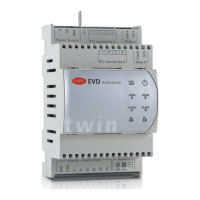ENG
“EVD Evolution TWIN” +0300006EN - rel. 2.6 - 31.01.2019
28
Note: if several inputs are associated with the same logical meaning,
EVD Evolution considers the one associated with the input that has the
highest index.
Examples
EXAMPLE 1
Sharing of the 0 to 10 V input to control two valves in parallel with the same
input.
• Main control_1 = 0 to 10 V programmable positioner;
Main control_2 = 0 to 10 V programmable positioner.
• Programmable control conguration_1 = 00060; PID control function =
f(S1)+f(S2)+f(S3)+f(S4). The other settings not aect.
Programmable control conguration_2 = 00060; PID control function =
f(S1)+f(S2)+f(S3)+f(S4);
• Programmable control input_1 = 0100 ->Measurement =S2
Programmable control input_2 = 0100 ->Measurement =S2
• Programmable control options_1 = XXXX, no aect
Programmable control options_2 = XXXX, no aect
• Programmable control set point_1 = X.X, no aect
Programmable control set point_2 = X.X, no aect
EVD Evolution twin shares the input associated with probe 2 and moves the
two valves in parallel.
EXAMPLE 2
Superheat control with hot gas bypass by temperature. Programmable control
is used to add the high condensing temperature protection (HiTCond).
• Main control_1 = 22 -> Programmable SH control;
• Main control_2 = 13 -> Hot gas bypass by temperature.
• Programmable control conguration_1=01010,
1) Direct PID temperature control;
2) HiTcond control enabled;
3) Temperature (°F/psig), absolute;
4) Measurement function: f1(S1)+f2(S2)+f3(S3)+f4(S4);
• Programmable control input_1 = 4100-> Measurement =-Tdew(S1)+S2
• Programmable control options_1 = 2140
1) S1 = Evaporation pressure
2) S2 = Suction temperature
3) S3 = Condensing pressure
4) S4 = Not used
• Programmable control set point_1 = 10 K
E
V
M
S
F
L
CP
EVB
C
TB
S1
EVD evolution
twin
S4
PA
PB
TA
EEVA
S2
S3
Fig. 5.p
5.7 Control with refrigerant level sensor
In the ooded shell and tube evaporator and in the ooded condenser, the
refrigerant vaporises outside of the tubes, which are immersed in the liquid
refrigerant. The hot uid owing through the tubes is cooled, transferring heat
to the refrigerant surrounding the tubes, so that this boils, with gas exiting
from the top, which is taken in by the compressor.
Parameter/description Def Min Max UOM
CONFIGURATION
Probe S1
…
24 = CAREL liquid level
…
Ratiometric:-1…9.3
barg
-- -
Main control
…
26 = Evaporator liquid level
control with CAREL sensor
27 = Condenser liquid level
control with CAREL sensor
Multiplexed cabinet/
cold room
-- -
CONTROL
Liquid level set point 50 0 100 %
The action is reverse: if the liquid level measured by the oat level sensor is
higher (lower) than the set point, the EEV valve closes (opens).
Setpoint = 50 %
MAX = 100 %
EEV
S1
EVD
evolution
S2
FLOODED
SHELL AND
TUBE EVAPORATOR
FROM
CONDENSER
TO
COMPRESSOR
S
E
MIN = 0 %
Fig. 5.q
Key:
S Float level sensor
EEV Electronic valve
E Flooded evaporator
For the wiring, see paragraph “General connection diagram”.
With the condenser, the action is direct: if the liquid level measured by the
oat level sensor is lower (higher) than the set point, the EEV valve closes
(opens).

